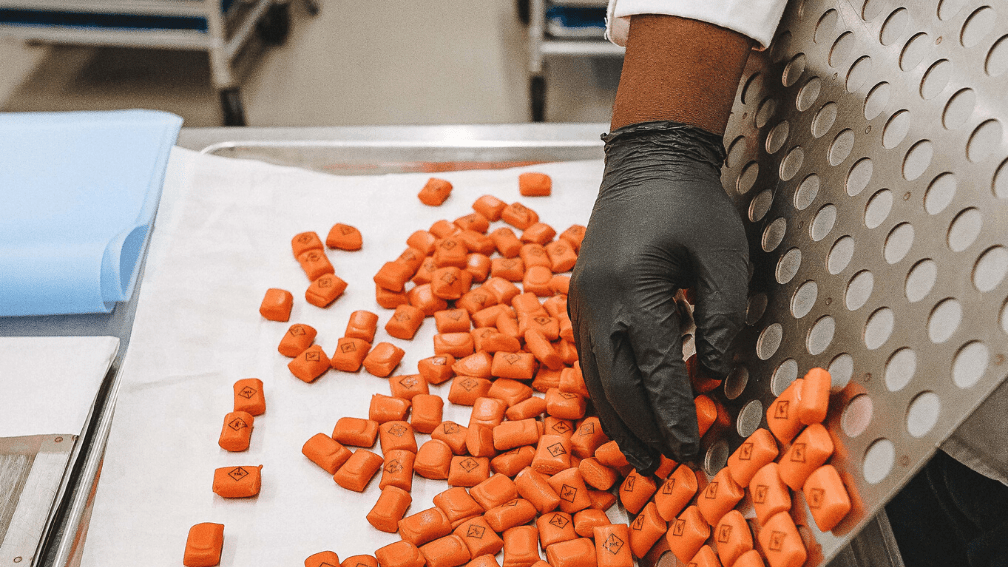Let’s Talk Terpenes
- By Steven Turetsky


Every morning driving eastbound towards Dixie; I-70 is an aromatic rollercoaster. As I merge onto the highway at Brighton Boulevard, the putrid odor of the Purina Puppy Chow factory overwhelms my sensitive recently awoken nostrils. To make matters worse it lingers as I sit in traffic up to Colorado Boulevard, where I finally receive some reprieve from the Safeway bread factory. As the traffic gives way to open road, my windows go down and my stereo goes up, as I’m quite fond of the aroma that lies ahead. The road-tripping tourist may mistake it for a poor skunk that met its maker, or maybe that’s a lemonade factory, or wait maybe it’s a place that makes those pine tree air fresheners. Whichever it is, for travelers going westbound it’s the perfect ‘Welcome to Denver’ sign.
You know you’ve arrived in pot paradise. So where do these eclectic and potent cannabis smells you’re enjoying come from? Many are now familiar with the medicinal molecular family known as phytocannabinoids (THC, CBD, etc.), but there is another set of molecular players in our beloved plant that are gaining attention rapidly in the cannabis industry. These stinky and tasty molecules are called Terpenes. Terpenes are what make Lemon Skunk and Pineapple Express smell like a tropical beverage and what makes creates the dank musky goodness of Blue Dream or OG Kush.
These same commute-saving smells have been researched for decades, as they are found in almost all plants, and are found to have some intriguing medical and wellness benefits. It’s been theorized that terpenes have actually been playing a leading role in whole plant cannabis therapies rather than the THC-accompanying cannabinoids we hear about. Due to decades of selective breeding for high THC potency, many of the trace cannabinoids were nearly bred out of strains. Nonetheless, the smell remained and the medical evidence was still as compelling so it thought that terpenes were major contributors. Thus, a combination of trace cannabinoids and terpenes in conjunction with THC are shown to provide amplified benefits that are greater than the sum of their individual parts. This is known as cannabinoid synergy.
Now for a crash course in some of cannabis’ most abundant terpenes.
Limonene (Lime-o-neen)
Limonene has a citrus aroma and taste and is found in many sativa strains. It is commonly used in aromatherapy as a mood booster and can alleviate depression. Limonene probably plays a key role in the uplifting euphoria associated with sativa strains. Limonene is also a potent anti-fungal, anti-bacterial, anti-carcinogen, and can alleviate acid reflux and digestive ailments. Other natural sources of limonene include citrus fruits and herbs like peppermint and rosemary.
Myrcene (Meer-scene)
Myrcene provides an earthy skunk smell and flavor to cannabis. Most abundantly found in Hops, a cousin of cannabis, Myrcene is known for its sedative effects and shows promise as a sleep aid. Makes sense if you think about the common effects of beer. Scientists believe Myrcene plays a key role in the relaxing effects associated with indica strains. Try adding essential oil that contains Myrcene, like lemongrass or mango essential oil, to your tea before bed for a super-charged sleepy time tea!
Pinene (Pie-neen)
Alpha-Pinene, one of the pinene isomers, is the most abundant terpene found in nature and as you probably guessed, plays a big role in pine trees and needles. The smell and taste actually acts as an insect repellent for pines and other conifer trees. It produces a fresh air, piney smell and flavor found in strains like Chemdawg and Trainwreck. Pinene is a potent bronchodilator and therefore could be helpful in treatment of asthma. In cannabis consumption, it aids in alertness found in sativa strains and actually may mitigate THC side-effects like the always hampering short term memory loss. Imagine a sci-fi pinene-enriched extract that could actually increase your memory (and fend off mosquitoes)!’
Linalool (Lynn-a-lool)
Lastly, lets talk about lavender-laced Linalool. Not only is it abundant in that purple herb, but also coincidently in your favorite purp strains like GDP, and Purple Kush. Linalool is a calming constituent in many essential oil blends as it is proven to reduce anxiety and pain. It also is showing clinical promise as an anti-convulsant (think CBD). Another interesting study showed Linalool and CBD as anti-bacterials that could treat the core causes of acne. Get clear skin while getting high? Sign me up!
As you may have noticed, a lot of terpenes have similar therapeutic properties to cannabinoids. This is because they affect the same CB and TRP receptors as cannabinoids. Thus, the exciting possibility exists of future synergistic applications that utilize unique ratios of cannabinoids and terpenes in conjunction. The ultimate goal being to provide all-natural amplified effects that could be exponentially more therapeutic than whole plant cannabis or individual cannabinoid extracts. Hmmmm……











